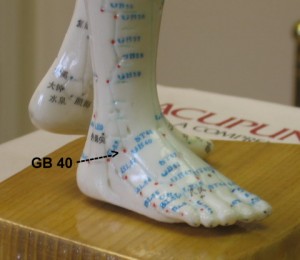Hill Ruins (qiu xu)
GB 40 (GB refers to the Gallbladder channel, 40 is the number of the point on the channel)

Hill Ruins is located just below the ankle at the top of the foot, near the ankle bone on the outside of the foot.
Hill Ruins is not one of the most commonly used acupuncture points, but I want to highlight it this month to acknowledge the season. We are finally seeing spring here, with new growth on the plants and bulbs flowering up from the ground. The weather is warmer (for the most part) and everyone wants to be outside in the sunshine and spring air.
In Chinese medical theory, this is the time of year when the Yang1 aspect is developing. During the winter the Yin aspect was relatively abundant, and during the summer the Yang aspect is relatively abundant. The spring is a transition period with the growth of the Yang aspect. In the body, the Liver2 and Gallbladder systems are associated with the spring. At this time the energy of the Liver and Gallbladder systems is increasing and becoming more active.
Hill Ruins may be indicated if there is an imbalance in the Gallbladder/Liver systems. It is the ‘source’ point of the Gallbladder channel, and can treat an imbalance anywhere along the channel. The Gallbladder channel flows from the feet to the head, and has a number of pathways connecting from the main channel in the head to the eyes, ears, and jaw.
Although Hill Ruins is typically considered for local problems like ankle pain/injury, it can be used for problems along the channel at the head too. If one is experiencing an increase in headaches, eye discomfort, or sinus problems at this time of year this point can be used to relieve one’s symptoms.
1 Yin aspect : Yang aspect
Yin and Yang are “…convenient labels used to describe how things function in relation to each other and to the universe. They are used to explain the continuous process of natural change.”
“The character for Yin originally meant the shady side of a slope. It is associated with such qualities as cold, rest, responsiveness, passivity, darkness, interiority, downwardness, inwardness, and decrease.
The original meaning of Yang was the sunny side of a slope. The term implies brightness and is part of one common Chinese expression for the sun. Yang is associated with qualities such as heat, stimulation, movement, activity, excitement, vigor, light, exteriority, upwardness, outwardness, and increase.”
Ted Kaptchuk, The Web that has no Weaver (Chicago: Congdon & Weed Inc., 1983) 8.
2 Selected words are capitalized to indicate that they represent Chinese medical theoretical concepts. They do not refer to the western medical concept of the organs.